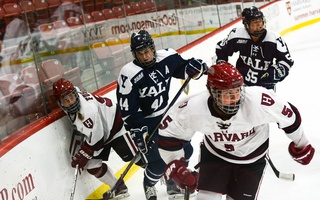{shortcode-ea138ddc05f06b1024f1dd6fb3dac0f182446cba}
As athletes return to the courts and fields, some will be stepping into a new role—“chief marketing officer”—as part of a new initiative within the Athletics Department aimed at boosting game attendance and team awareness.
As “CMOs” for their teams, student athletes will work with Athletics marketing and communications staff to promote important games and publicize team events and games in the Houses. The new program seeks to increase communication and support between the College’s 42 varsity teams and Athletics marketing department, according to Associate Director of Athletics Susan Byrne.
The head coaches from each team have recommended student athletes to serve as the chief marketing officers for their teams for this year. The position is not paid.
“We hope that they can serve as a liaison to the marketing department,” Byrne said. “We’ll be here as a resource for them, and then they really will act as their team’s brand ambassador.”
Student CMOs will also be involved in coordinating the student rewards program, an Athletics initiative that using the Harvard CrimZone Rewards mobile app to promote certain games by giving away Harvard merchandise or advertising free food.
Students involved in the program will attend three meetings with the marketing and communications staff throughout the year in addition to working with them on specific team projects. Athletics administrators stress that the new responsibilities will be manageable with student’s academic and athletic schedules.
“It’s more than just Tweeting a picture from practice, and it’s supposed to be,” said Timothy J. Williamson, a spokesperson for the department. “But obviously knowing that for someone on the team, with all the commitments they have, it’s not going to be an all-day, everyday thing.”
Initial response to the initiative has been positive, according to Byrne. Head coach for women and men’s squash Michael D. Way emphasized the potential of the new marketing program to help smaller teams promote the team and grow their fan bases.
“When you think of football and basketball and probably even ice hockey, it’s not too tough to get bums in the seats,” he said. “For the smaller sports, of which we are one, anything that is going to promote our program and promote our sport and hopefully raise awareness and increase attendance is a going to get our attention.”
Way said he hopes that students involved as the chief marketing officers for the men’s and women’s teams will be able to bridge the gap between the Athletics Department and the broader Harvard student body, especially when it comes to raising attendance at big events like the women’s national competition.
“Anything that can get more students to cross that bridge, the chasm between Harvard Athletics and the campus, and get them to court is also going to help,” he said.
In addition to increased communication between the varsity teams, the Athletics Department, and the College, Byrne emphasized that the new initiative provides student athletes with additional leadership and networking opportunities.
“I think there is a lot of opportunity to learn on the parts of the students and put this leadership role on their resume,” she said.
The program will kick off on Wednesday evening with the new chief marketing officers' first meeting.
—Staff writer Brittany N. Ellis can be reached at brittany.ellis@thecrimson.com. Follow her on Twitter @britt_ellis10.
Read more in News
Alumni Call on IOP to Drop Lewandowski and SpicerRecommended Articles
-
CrimZone Rewards Program Sees Rapid GrowthWith free t-shirts and pizza, Harvard’s Athletics Department is successfully luring increasing numbers of students across the river to attend varsity sports games through its CrimZone Rewards program and has doubled attendance at select games.
-
 In Harvard’s Athletics Department, A Stark Wage Gap
In Harvard’s Athletics Department, A Stark Wage Gap -
 Athletics Department to Overhaul Complaints Process
Athletics Department to Overhaul Complaints Process -
A Kickoff for ChangeCompelling all teams to undergo training on diversity and sexual harassment begins a conversation, but preventing “locker room talk” will require a broader cultural shift than five sessions a year.
-
 Home Field Advantage?
Home Field Advantage?













